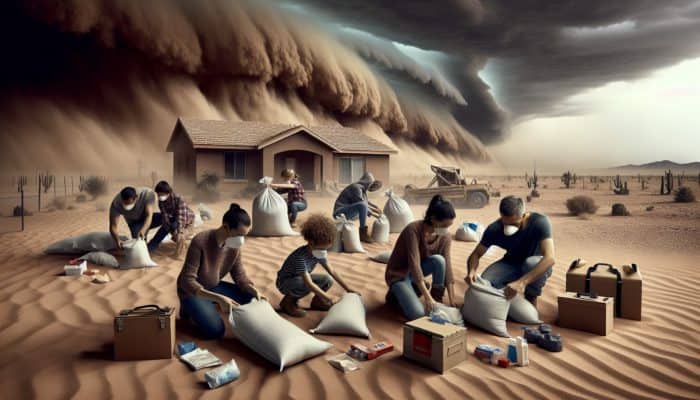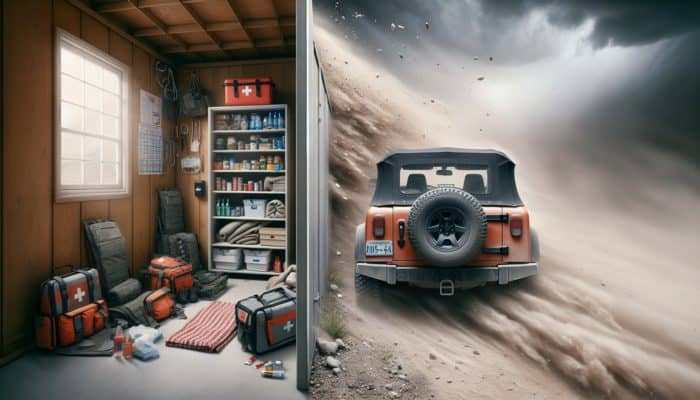Mastering Dust Storm Dynamics: Essential Insights for Effective Action
When encountering a dust storm, preparedness is of utmost importance. These powerful natural phenomena can strike unexpectedly, presenting significant challenges to anyone caught in their path. It is crucial for residents, particularly in areas prone to these storms, to comprehend their formation and the inherent dangers. Regions across the globe marked by aridity are often the most affected, facing disruptions to daily life and experiencing notable health risks. Consequently, it is imperative to devise and enact effective strategies for surviving a dust storm, ensuring both health safety and personal security during these unpredictable occurrences.
Unpacking the Forces Behind Dust Storm Development

Dust storms primarily arise from intense wind conditions that elevate loose soil and sand into the atmosphere, particularly under dry climates. These storms typically form when strong winds interact with barren, arid ground, creating the ideal scenario for dust to ascend into the air. Areas like the Sahel in Africa, regions historically affected by the Dust Bowl in the United States, and specific Australian locales are especially susceptible due to their distinct environmental characteristics. For both residents and visitors within these vulnerable regions, grasping the fundamental causes of dust storms is essential for enhancing safety and preparedness.
When wind speeds surpass a critical threshold—varying based on geographic and soil conditions—dust and sand particles become airborne. These particles can traverse extensive distances, sometimes spanning hundreds of miles. The outcome is often a striking wall of dust, which can swiftly advance and drastically diminish visibility to almost nothing. Such circumstances pose significant hazards for anyone caught in the storm's trajectory, underscoring the profound physical and environmental consequences of these events.
Recognising the fundamental factors contributing to the occurrence of dust storms is vital for both local inhabitants and visitors in these affected areas. Meteorological phenomena, including high-pressure systems that trigger drought conditions, significantly heighten the chances of dust storms. Furthermore, anthropogenic activities—such as deforestation and inefficient agricultural practices—can worsen dust storm conditions by destabilising soil and diminishing vegetation cover, illustrating the need to consider both natural and human influences on the dynamics of dust storms.
Identifying Early Warning Signals of Oncoming Dust Storms
Recognising the early warning signs of an impending dust storm is essential for prompt action. One of the most prominent visual indicators is the emergence of a dust wall on the horizon, which may resemble a dark cloud or dense fog. This visible cue typically serves as a forewarning that a dust storm is on its way. As the storm approaches, a marked reduction in visibility becomes evident; distances that were once clearly visible can quickly become obscured, creating perilous situations for those nearby.
A sudden increase in wind speed is another significant sign of an impending dust storm. A rapid alteration in wind patterns, particularly when coupled with dry air, indicates that immediate precautions are necessary. Dust storms can develop swiftly with little advance notice, and being aware of these visual and sensory indicators can greatly improve your readiness and response capabilities. Maintaining vigilance and proactive awareness are crucial components for ensuring safety amid such unpredictable weather phenomena.
Meteorological forecasts offer invaluable insights regarding potential dust storm occurrences. Numerous weather services provide alerts and predictions based on current conditions, wind patterns, and historical data. By staying informed through these forecasts, individuals and communities can better anticipate and prepare for dust storms, implementing safety measures well in advance of the storm's arrival, ultimately reducing risks and enhancing overall safety.
Essential Preparations for Dust Storms: Comprehensive Guidelines
While meteorological forecasts can often predict the likelihood of dust storms, abrupt weather changes may also hint at their imminent arrival. Regions frequently impacted by dust storms, including the Middle East and North Africa, have developed sophisticated monitoring systems to track atmospheric conditions. The utilisation of satellite imagery and weather radar enables real-time data collection, improving predictive capabilities and preparedness efforts.
Local weather stations routinely issue dust storm warnings, providing communities with the information necessary to prepare and respond appropriately to these events. For instance, in areas that experience seasonal dust storms, such as the Khamsin winds in Egypt, residents can implement precautionary measures, including formulating emergency plans and remaining indoors during peak storm activity to protect their health and property.
Staying informed about weather trends and leveraging available resources is vital for mitigating the impacts of dust storms. Engaging with local meteorological services, utilising apps for real-time updates, and participating in community alert systems can significantly enhance your preparedness and response strategies during these potentially hazardous conditions.
Essential Steps for Successfully Navigating Dust Storms

Effective preparation is critical to ensure that you can survive a dust storm with minimal adverse effects. By implementing suitable strategies and assembling necessary supplies, you can significantly diminish the risks associated with these powerful weather events. The following steps outline vital preparations that individuals and families should undertake to enhance their safety and resilience during dust storms.
Assembling a Comprehensive Emergency Kit for Dust Storms
An emergency kit serves as a crucial resource for anyone residing in or travelling through areas prone to dust storms. Your kit should encompass essential supplies, including sufficient water, non-perishable food items, a flashlight, first-aid supplies, and a dust mask to protect against inhaling dangerous particles. Water is particularly critical, as the risk of dehydration can escalate rapidly during a dust storm, especially if you find yourself outdoors when it strikes.
It is advisable to prepare your emergency kit with enough provisions to last at least three days. Include items like canned goods, dried fruits, and protein bars, which can offer essential energy without necessitating cooking facilities. Moreover, having a dependable flashlight or battery-operated lantern is invaluable, especially if the storm causes power outages, enabling you to navigate safely in low-light conditions.
Furthermore, consider adding a portable phone charger to your emergency kit. During emergencies, maintaining communication channels and receiving updates is essential for your safety. Remember to review your emergency kit at least once a year to ensure that all items remain in good condition and that food and water supplies are still suitable for use in an emergency situation.
Fortifying Your Home: A Critical Component of Dust Storm Preparedness
Prior to a dust storm's arrival, it is essential to prepare your home to mitigate dust infiltration. Securely shut all windows and doors, sealing any gaps that could permit dust entry. Applying weatherstripping can enhance your home’s seals, while covering air vents or intakes can avert dust circulation indoors, thereby preserving better air quality during storms.
In addition to safeguarding your home, it is prudent to prepare your outdoor areas. Relocate lightweight furniture and decorations indoors, and secure heavier items that could become airborne in strong winds. If you maintain a garden, covering it with tarps or blankets can shield plants and soil from the harsh effects of dust, preserving their integrity and health during the storm.
Creating a dust storm preparedness checklist can help ensure that you do not overlook any critical steps in your preparations. This checklist might encompass tasks such as verifying the functionality of your ventilation systems and ensuring that your home’s air filtration systems are operating effectively. A clean filter can be instrumental in maintaining indoor air quality during and after a dust storm.
Preparing Your Vehicle for Dust Storm Conditions

Your vehicle can provide shelter during a dust storm if correctly prepared. Whenever possible, park your vehicle in a safe, sheltered location, such as a garage or covered parking space. If indoor parking is unavailable, select a site away from trees and structures that could collapse or shed branches during the storm.
Ensure that all windows are tightly closed and turn off the air conditioning to prevent dust from entering the vehicle. Soft-top vehicles, particularly convertibles, are especially vulnerable during dust storms; if you own one, consider finding a hardtop vehicle or a secure location to protect it from potential damage.
If you must drive during a dust storm, verify that your vehicle’s windshield wipers are functioning correctly. This preparation is crucial for enhancing visibility should rain accompany the storm. Always keep emergency supplies, such as water and a first-aid kit, in your vehicle at all times to be ready for any situation that may arise.
Staying Informed About Weather Conditions for Effective Dust Storm Preparation
Remaining informed about weather conditions is imperative for effective dust storm preparation. Regularly check weather forecasts, utilise weather apps, and listen to local radio stations for updates on potential dust storms in your vicinity. Many meteorological services provide alerts via text or email, delivering timely notifications about imminent storms and allowing for proactive measures to be implemented.
Engaging with local community forums and social media groups dedicated to weather updates can significantly enhance your knowledge and preparedness. Sharing experiences and practical tips with others can foster a supportive network that strengthens community resilience during challenging weather events.
Moreover, consider investing in a weather radio that broadcasts emergency information. This device can be invaluable during power outages, ensuring that you receive critical updates regarding storm conditions and safety recommendations. Remaining connected and informed during a dust storm can substantially impact your ability to navigate these events successfully and safely.
Ensuring the Safety of Livestock and Pets During Dust Storms
For those residing in rural areas with livestock and pets, adequately preparing them for dust storms is essential. Confirm that all animals have access to secure shelter where they can be shielded from flying debris and dust. Structures should be sturdy and well-ventilated, providing a safe haven for animals during and after a storm.
Access to clean water is crucial throughout a dust storm, as dust can contaminate water sources, rendering them unsafe for consumption. Consider establishing multiple water supplies in sheltered areas to ensure that animals can remain hydrated during the storm.
For household pets, bringing them indoors during a storm, if feasible, is advisable. Create a secure space for them that promotes calmness, incorporating familiar items such as blankets or toys to help alleviate their stress during the storm. Taking these precautions demonstrates a commitment to their well-being and safety throughout these challenging weather events.
Proven Strategies for Ensuring Safety During Dust Storms
When a dust storm strikes, knowing how to respond swiftly can be pivotal in saving lives and minimising health risks. Here are essential strategies to implement for maintaining safety during these formidable weather occurrences.
Seeking Immediate Shelter During Dust Storms
The foremost rule during a dust storm is to find shelter without delay. If you are outdoors, aim to locate a sturdy building or vehicle for protection. Avoid remaining in open areas, as winds can carry debris and dust in your direction, resulting in serious injury risks.
If you find yourself driving during a dust storm, remain composed and avoid panicking. Reduce your speed to maintain control of your vehicle; visibility can diminish quickly. If visibility decreases to zero, safely pull over to the side of the road, turn off your headlights, and remain inside your vehicle until the storm passes. This approach is crucial for preventing accidents and minimising exposure to harmful dust particles.
For those indoors, ensure that windows and doors are tightly sealed to prevent drafts from entering. Turn off air conditioning and fans that could draw in dust. If respiratory difficulties arise, wearing a dust mask or covering your nose and mouth with a cloth can help filter out harmful particles, thus protecting your health during the storm.
Prioritising Respiratory Protection During Dust Storms
Protecting your respiratory health during a dust storm is of paramount importance. Dust particles can lead to a range of health issues, particularly for individuals with existing conditions such as asthma or chronic obstructive pulmonary disease (COPD). Wearing a dust mask or a cloth over your nose and mouth can significantly lessen the risk of inhaling harmful particles.
It is advisable to remain indoors as much as possible during a dust storm, especially for vulnerable populations like children and the elderly. If available, using air purifiers can assist in filtering out dust particles and improving indoor air quality. If an air purifier is not accessible, keep windows closed and utilise damp cloths to wipe down surfaces to manage indoor dust levels effectively.
Monitoring your health during and after the storm is essential. If persistent coughing or difficulty breathing occurs, seek medical attention promptly. Being proactive about your health during these events can help avert long-term complications related to dust inhalation, ensuring your overall well-being.
Staying Calm and Informed During Dust Storms
In the midst of a dust storm, remaining calm and informed is critical for effective decision-making. Pay attention to local emergency broadcasts for updates and adhere to any directives from authorities. Communicating with neighbours can also be beneficial; sharing information and experiences can offer additional guidance and support during tumultuous times.
Engaging in calming activities such as reading or listening to music can help alleviate anxiety levels. Maintaining a composed mindset allows for improved decision-making, particularly in emergencies. Focus on preparedness efforts and ensure that all household members are accounted for and safe, fostering a sense of security and peace of mind.
Establishing a communication plan with family members can relieve panic and ensure that everyone understands their responsibilities during a storm. Designating a meeting point in case of separation can provide reassurance to all involved, enhancing overall safety during these challenging situations.
Successfully Navigating Dust Storms: Strategies for Safe Passage
When caught in a dust storm, knowing how to navigate safely is vital for protecting yourself and others. The following strategies will guide you through the challenging circumstances presented by dust storms.
Safe Driving Techniques in Dust Storm Conditions
If driving during a dust storm is unavoidable, prioritise safety above all else. Significantly decrease your speed; visibility can deteriorate rapidly. Use your headlights to enhance visibility, but avoid using high beams, which can reflect off the dust and exacerbate visibility issues.
In severe conditions, pull over to a safe location, ideally one that is clear of trees, power lines, and other vehicles. Turn off your headlights and remain inside your vehicle. This method minimises the risk of an accident and protects you from airborne debris and dust.
Avoid making abrupt movements that could lead to loss of vehicle control. Maintain a safe distance from other cars, as limited visibility can result in unexpected stops or slowdowns. Tune in to local traffic updates for information regarding road conditions during the storm to remain informed and safe.
Effectively Using Navigation Aids During Dust Storms
Relying on GPS or other navigation tools is essential when traversing a dust storm. However, be prepared for sudden visibility changes that may hinder your ability to follow directions accurately. Ensure your navigation devices are charged and readily accessible at all times.
In instances of severe storm conditions, consider postponing your journey until visibility improves. It is often safer to remain stationary than to risk driving under dangerous visibility conditions.
If you find yourself lost, do not panic. Familiarise yourself with local landmarks, use maps, or access offline maps available in various applications. Planning routes that avoid areas known for severe dust storm activity can enhance your safety in future travels.
Avoiding Hazards During Dust Storms
Dust storms introduce various hazards, including fallen debris, power lines, and stalled vehicles. If navigating during a storm, remain vigilant for these potential dangers. Stay alert and avoid areas with significant debris or hazards that could threaten your safety.
If you encounter downed trees or power lines, report them immediately to the relevant authorities. Avoid attempting to address the situation yourself, as many hazards can pose serious risks to personal safety and well-being.
Additionally, be mindful of other vehicles on the road. Watch for cars that may have come to an abrupt stop due to low visibility. Maintaining a safe distance from other vehicles helps prevent collisions or accidents during these challenging conditions.
Wearing protective gear is essential during a dust storm. Using goggles can shield your eyes from dust particles and debris. Pairing goggles with masks or cloths helps filter out harmful dust, providing a comprehensive approach to remaining safe during these unpredictable weather events.
Implementing Personal Protection Strategies During Dust Storms
Ultimately, protecting yourself during a dust storm requires proactive measures. Use a mask or cloth over your nose and mouth to filter out dust particles that can worsen health issues. Additionally, goggles can protect your eyes from both dust and flying debris, enhancing your overall safety.
If you must be outdoors, limit your exposure as much as possible. Seek sheltered areas and stay low to the ground when conditions worsen. Remaining low minimises the risk of inhaling large amounts of dust and shields your body from airborne debris and particulate matter.
After the storm has passed, allow time for the dust to settle before venturing outside. Air quality may remain hazardous for hours or even days following a storm due to lingering particles. Consulting local air quality reports can help ascertain when it is safe to resume outdoor activities.
Recovery Strategies Following a Dust Storm Event
Once a dust storm has ceased, the focus shifts to recovery and evaluating the impacts on your environment and personal well-being. Here are the critical steps to undertake after a dust storm event.
Assessing Damage Post-Dust Storm
After the storm has cleared, it is essential to inspect your home and vehicle for any damage sustained during the storm. Look for broken windows, compromised roofs, or structural issues that may require immediate attention. Documenting damage with photographs can be advantageous for insurance claims and repair assessments, providing a clear record of the impacts.
Your vehicle also necessitates thorough inspection. Dust can accumulate on surfaces, potentially leading to issues if not addressed promptly. Examine the engine, filters, and exterior for signs of debris accumulation. Scheduling a comprehensive maintenance check can ensure that your vehicle remains safe and functional following the storm.
Evaluate your surroundings, especially if you reside in areas with abundant trees or vegetation. Falling branches or uprooted plants can create hazards in your yard. Promptly addressing any issues can prevent future complications, ensuring a safer environment for everyone.
Safely Cleaning Up After Dust Storms
Cleaning up after a dust storm necessitates careful consideration for health and safety. Wearing protective gear, including masks and gloves, is essential to shield yourself from dust exposure while sweeping or cleaning surfaces.
Begin by removing large debris or dust accumulation from driveways, walkways, and outdoor areas. Use a damp cloth or mop to wipe down surfaces inside your home, effectively reducing dust levels. Consider employing a vacuum outfitted with a HEPA filter for thorough indoor cleaning, targeting fine dust particles.
Dispose of waste responsibly, ensuring compliance with local regulations regarding hazardous materials. If debris includes broken glass or sharp objects, handle them with extreme caution to avoid injury. Adopting these precautions can streamline the cleanup process and maintain a safe and healthy environment.
Restoring Normalcy After a Dust Storm
Returning to regular activities following a dust storm may take time, and it’s important to approach this process gradually. Assess your environment and complete any necessary repairs before resuming your usual routines to ensure safety and comfort.
Communicating with family members about their experiences during the storm is essential. Sharing feelings can foster emotional support and help everyone adapt to the aftermath of the event, promoting collective healing and recovery.
As you reintegrate into daily life, ensure that all safety measures are in place and that any required repairs have been completed. For communities, organising support groups or cleanup initiatives can foster resilience and encourage collective rebuilding efforts in the wake of a dust storm event.
Long-Term Planning for Dust Storm Preparedness
Being prepared for future dust storms requires continuous education and a commitment to readiness. Establishing long-term strategies can enhance your ability to adapt effectively to these events.
Educating Your Family on Dust Storm Safety and Readiness
Teaching family members about dust storm safety is essential for cultivating a culture of preparedness. Involve children in conversations about dust storms, their potential impacts, and how to identify early warning signs and appropriate responses during an emergency.
Developing a family emergency plan that outlines roles and responsibilities empowers everyone to act effectively in the event of a storm. Conducting drills can reinforce these concepts, ensuring that all family members are prepared to respond if they find themselves in a dust storm situation.
Consider engaging with local community programmes or workshops focused on weather preparedness. These educational resources can deepen your family’s understanding and readiness for future dust storms, promoting a proactive approach to safety.
Maintaining and Updating Your Emergency Supplies
Regularly examining and replenishing your emergency kit is vital for ensuring it is ready for use. Establish a schedule for evaluating supplies, particularly perishable items like food and water, which often have expiration dates. Replace expired items and verify that all equipment, such as flashlights and batteries, is functional and prepared for action.
Consider expanding your emergency supplies to include additional items, such as a portable phone charger, emergency blankets, and a multi-tool. A well-stocked kit significantly enhances your ability to respond effectively to any situation that may arise during a dust storm or other emergencies.
Maintaining supplies is not merely a one-time task; it necessitates ongoing commitment to preparedness. By developing a routine for checking and restocking your emergency kit, you can ensure that it remains functional and ready for immediate use at all times.
Staying Informed About Dust Storm Risks and Weather Alerts
Remaining informed about weather forecasts and emergency alerts is crucial for future dust storm preparedness. Subscribe to local news outlets, weather apps, and community alert systems that provide real-time updates on weather conditions, ensuring you are always aware of potential risks.
Engaging with local meteorological services and participating in community discussions can enhance your understanding of potential dust storm risks and preparedness strategies. Sharing this information with neighbours can help create a network of preparedness, thereby strengthening community resilience.
By prioritising education and remaining vigilant, you can ensure that you are equipped to face future dust storms confidently and effectively, safeguarding your health and well-being.
The Community's Role in Dust Storm Preparedness and Recovery
Communities play a vital role in addressing the challenges posed by dust storms. Collaborative efforts can significantly enhance preparedness and recovery, ensuring that everyone has the necessary support during these events.
Establishing Community Support Networks for Dust Storm Events
Supporting neighbours during dust storms fosters a sense of solidarity and resilience within communities. Check in on elderly or vulnerable individuals in your area, offering assistance in preparing for storms or helping with post-storm cleanup to cultivate a spirit of cooperation.
Creating a support network can enhance preparedness and facilitate resource sharing. Establish community groups focused on dust storm awareness; providing educational resources and sharing experiences can assist others in need, ensuring that no one faces these challenges alone.
Moreover, organising community drills and preparedness workshops ensures that everyone understands the necessary steps to take during a dust storm. Engaging in these activities strengthens community bonds and enhances collective resilience, preparing everyone for future events.
Implementing Community-Level Preparations for Dust Storms
Communities can mitigate the impact of dust storms by understanding necessary precautions and preparations. Local governments should collaborate to secure infrastructure and develop emergency plans that address the specific risks associated with dust storms.
Community education initiatives can focus on raising awareness of best practices for dust storm preparedness and mitigation. Workshops can cover topics such as emergency kit preparation, securing homes, and strategies for effective weather monitoring, empowering residents with the knowledge they need.
Encouraging local businesses to adopt dust storm preparedness plans can further enhance community resilience. Creating a comprehensive plan that addresses potential dust storm impacts ensures that businesses are equipped to serve their customers effectively during challenging times.
Coordinating Community Recovery Efforts After Dust Storms
Following a dust storm, community recovery efforts play a significant role in restoring normalcy. Establishing cleanup initiatives brings people together, fostering collaboration and mutual support as communities work to recover from the impacts of dust storms.
Engaging with local organisations and volunteers can enhance recovery efforts, ensuring that cleanup and rebuilding processes are effective and efficient. Sharing resources and information among community members facilitates a smooth recovery process, allowing everyone to rebuild together.
In addition to physical cleanup efforts, communities should also provide mental health support, as dust storms can have psychological impacts on residents. Offering counselling services or support groups can help individuals process their experiences and promote positive recovery.
Common Questions (FAQs) Regarding Dust Storms
What actions should I take if I find myself outside during a dust storm?
If you are outdoors, seek immediate shelter in a sturdy building or vehicle. Avoid driving if possible, and protect your respiratory health by covering your nose and mouth with a cloth to filter out harmful dust particles.
How can I effectively prepare my home for a dust storm?
To prepare your home, ensure windows and doors are tightly sealed, cover air vents, and secure outdoor furniture and belongings. Create an emergency kit with essential supplies like water, non-perishable food, and a dust mask to protect against inhalation hazards.
What health risks are associated with exposure to dust storms?
Health risks from dust storms include respiratory issues, allergies, and eye irritation. Individuals with pre-existing conditions like asthma may experience worsened symptoms, making it crucial to take preventive measures.
Can dust storms be predicted, and how can I stay informed?
While meteorological forecasts can reasonably predict dust storms, sudden weather changes may also indicate their approach. Regularly monitoring weather updates is essential for maintaining preparedness and ensuring safety.
What essential items should I include in my emergency kit for dust storms?
Your emergency kit should include at least three days' worth of water and non-perishable food, a flashlight, first-aid supplies, and a dust mask to filter harmful particles.
How can I ensure my pets are safe during a dust storm?
Provide secure shelter for pets, ensure they have access to clean water, and bring them indoors if feasible. Creating a calm environment can help reduce their anxiety during the storm.
What immediate actions should I take after a dust storm passes?
After a dust storm, assess your property and vehicle for any damage, clean up safely while wearing protective gear, and gradually restore normal activities once it is deemed safe to do so.
How can communities effectively prepare for dust storms?
Communities can prepare by establishing comprehensive emergency plans, conducting educational workshops, and ensuring that local infrastructure is secure against the impacts of dust storms.
What is the best method to protect my respiratory system during a dust storm?
Utilise a dust mask or cloth to cover your nose and mouth. Staying indoors as much as possible and avoiding strenuous activities during the storm are also effective protective measures.
Where can I find reliable information about upcoming dust storms?
Check local weather reports, subscribe to emergency alert systems, and utilise weather apps to remain informed about potential dust storms in your area.
Join our journey on X!
The post Surviving a Dust Storm: Essential Safety Tips appeared first on Survival Bite.
The Article Essential Safety Tips for Surviving a Dust Storm Was Found On https://limitsofstrategy.com

